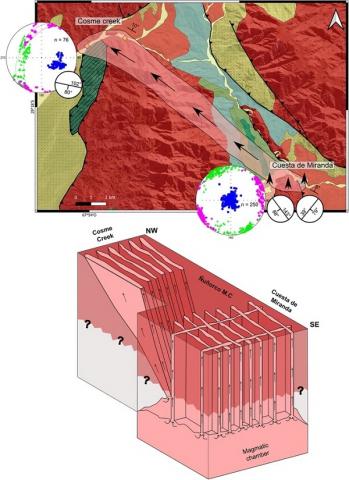A. Cukjati, C. M. Spagnuolo, P. R. Franceschinis, M. Bellante, M. A. Naselli, M. G. López de Luchi & A. E. Rapalini
2 025
International Journal of Earth Sciences, 13 September 2025
The development and emplacement of magmatic bodies during the Middle Paleozoic along the western margin of Gondwana remain poorly understood. To better constrain the nature of these processes, petrographic, anisotropy of magnetic susceptibility (AMS), anisotropy of anhysteretic remanent magnetization (AARM) and rock magnetic studies were performed in 326 specimens from 23 sites on Late Famennian—Early Tournaisian (∼357 Ma) basic dike swarms exposed at the Cuesta de Miranda (29°20′26″S; 67°46′3″W) and the Cosme Creek (29°15′27″S; 67°53′4″W) localities in the southwestern Famatina System, La Rioja province, Argentina. AMS results reveal that in the Cuesta de Miranda area, the maximum anisotropy axis (K1) is in a sub-vertical position, while in the Cosme Creek, it is dipping ∼40° towards the ESE, parallel to the strike of the dikes. Rock magnetic studies suggest that magnetite is the main mineral contributing to susceptibility. AARM studies confirm that the main axes of the susceptibility ellipsoid given by the AMS correspond to a “normal” fabric. The obtained results allow us to propose an emplacement model, in which the magmatic source that originated the dikes of the Cuesta de Miranda area was located under this region leading to a vertical flow of the magma at this locality. In the Cosme Creek, magma emplacement occurred due to an oblique upward flow that migrated around 15 km towards NW. In this area, all dikes exhibit similar AMS patterns despite petrographic differences among them. This suggests the emplacement of different magma pulses controlled by pre-existing regional structures.

